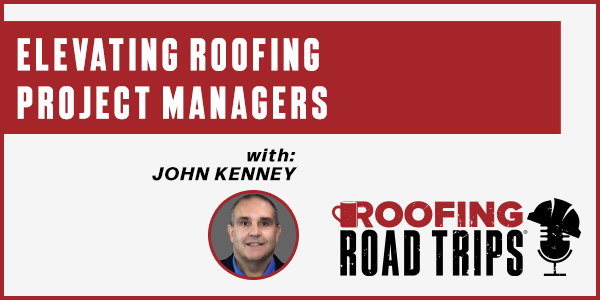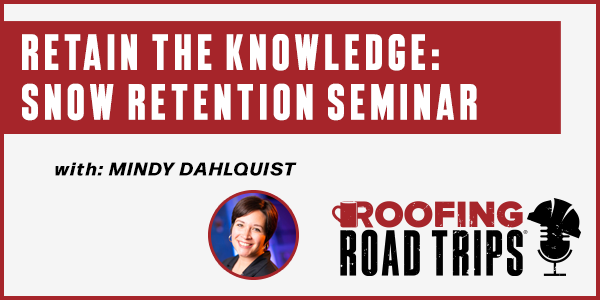Mindy Dahlquist - Retain the Knowledge: Snow Retention Seminar - PODCAST TRANSCRIPT
January 30, 2024 at 12:00 p.m.Editor's note: The following is the transcript of a live interview with Mindy Dahlquist from TRA Snow & Sun. You can read the interview below or listen to the podcast.
Intro: Welcome to Roofing Road Trips with Heidi. Explore the roofing industry through the eyes of a long-term professional within the trade. Listen for insights, interviews and exciting news in the roofing industry today.
Heidi J. Ellsworth: Hello and welcome to another Roofing Road trips from Roofers Coffee Shop. My name is Heidi Ellsworth and it's winter, it's snowing and there is so much that is going on with roofs under snow. In fact, we wanted to talk about snow retention. So we went out looking to find who can train and who can help with snow retention. And of course we looked to our friends at TRA Snow & Sun with Mindy Dahlquist to say, "Hey, what you got going?" And they've got stuff going. Hello, Mindy.
Mindy Dahlquist: Hi Heidi. How are you?
Heidi J. Ellsworth: I am so good. I'm so glad to have you here today. Before we dive in to this training and information that I'm really excited about, let's start out with you. Why don't you introduce yourself? Tell us a little bit about you and then about TRA Sun & Snow.
Mindy Dahlquist: Absolutely. Well, as Heidi said, I am Mindy Dahlquist. I am the business development manager at TRA Snow & Sun, so I've been with them for almost three years now. And I am a mom of three and I've got kids ranging all over the place. So I keep myself on my toes and I really just have been involved in the roofing industry and all of these things and seeing how we can help move forward and help progress the industry and also progress myself as well. So it's been great.
Heidi J. Ellsworth: I love it. It's so fun to work with you Mindy. It's been a great year or two years. It hasn't even been two years, a year and a half since we met.
Mindy Dahlquist: Yeah, I believe so.
Heidi J. Ellsworth: I know. I mean seriously, I'm looking out the window and we have about three feet of snow here in Central Oregon right now, and I know you in your area, you guys have tons of snow too. Let's talk a little bit about the inspiration and kind of the history of TRA Snow & Sun and how they got into snow retention.
Mindy Dahlquist: Absolutely. Well, Terry Anderson founded TRA Snow & Sun back in 1994, and so we're coming on our 30th year anniversary. And basically Terry was a salesperson and a consultant in the roofing industry with concrete tile. And so once he had sold quite a few jobs up in the mountain regions, found out that there was some problems that they ran into quite often with the heavy snow loads on different types of roofing materials.\
And so with that, he traveled to Europe and to other regions and to figure out how they handle snow specifically, and that is where he ran into snow retention. So actually snow retention is not something that we came up with. Anyone in the United States, it's something that has been used for centuries, but oftentimes it was things like boulders or logs that were placed on a roof to retain the snow. So with that, we started manufacturing snow brackets and then we've just taken it all over the place from there and to all different roofing material types and away from the focus of just the tile roof accessories, which is where TRA came from and kind of just progressed in the industry and wanted to make sure that we are handling education portions and not just selling a product, but making sure that the product is helping to be safe and reliable for the end user as well.
Heidi J. Ellsworth: Such a strong history. And as you were sitting there talking, I was remembering back in the day I worked with Terry and I can remember having articles coming out and talking about why you should keep snow on the roof if you have the engineering correct that it's a great insulator. And now a lot of that came from Europe.
Mindy Dahlquist: Yes, absolutely. It's interesting how we actually build our structures completely different here than they do in Europe in the mountainous regions. Here, we have this old thought process in our minds of we need to get that snow off of this roof. But unfortunately there's a lot of damage that comes with that and there's also a lot of risk as well. So it's nice to see that the ways are changing a little bit in certain areas, in certain builds at least to where there are some considerations for the risks and the damage that do come. Once that snow starts moving, it takes whatever with it. So it's nice to be noticed in the industry a little more.
Heidi J. Ellsworth: Let it melt naturally and insulate your house as long as you've got the engineering of course, where your house can handle that or your buildings. So let's talk a little bit about what happens, why the importance of snow retention? Because the climate is changing. We're seeing a lot heavier snow loads, we're seeing a lot that is going on further south than ever before. I mean, today's perfect example. People are getting snow everywhere. And why is snow retention important and what is really the safety considerations and risk mitigation that people should be thinking about?
Mindy Dahlquist: Absolutely. Well, I think a lot of times the thought process has been to clear the snow off the roof. So with that, you have people up on your roof in very sketchy scenarios, getting that snow off of the roof. And I know as far as rooftop accidents, that is pretty much the easiest way to have some kind of accident on a roof is sending somebody up in snowy and icy conditions to clear snow off of the roof. So not only is that a risk, but then you also have the risk of that snow sliding. So whether you clear the snow off or you use snow retention, that snow accumulates on your roof either way. So when that snow decides to slide, there's no perfect calculation for a date or a timeframe that that will happen or a certain weight that snow will weigh when it decides to actually slide off of the roof.
So death is something that unfortunately happens quite often when it comes to those rooftop avalanches. We unfortunately in Utah saw a death just in 2023 in the spring of a 50-year-old man, and then right in the same week, Durango, Colorado had a death of a little girl as well. So it is something that happens year after year and it's really... there's not a lot of information that comes with it. It's just usually called a freak accident and people who are not involved in it kind of move on with their lives and don't think of it down the road, but it's something that really needs to be considered in the amount of risk that's involved. And it's something that's kind of a simple fix.
Heidi J. Ellsworth: Yes, yes. Because there's science behind it and there's engineering, and this is really what TRA brings to the industry. And what I love is that it's not just about making a phone call to get the engineering or to whatever you need, but it's also about what you're doing with ongoing training. And this is one of the things I wanted talk about today. I really want to talk about your upcoming seminar where you are bringing solutions for that risk mitigation, so that save lives basically at the end of the day. Tell us a little bit about these seminars and how they're going to work.
Mindy Dahlquist: So, this is going to be our first ever educational seminar. And I don't know that there is another one like this out there that's going to be in-person live training. The day is just focused around snow retention specifically, not around all the other types of attachments and things like that that you can do. It's going to be focused solely on snow retention. So with this whole day, I mean, food is provided, it is a free event. For being in the industry for 30 years now, we want to make sure that we're sharing the information that we have. It's not gatekeeping at this point, it's truly just if I can make someone else better with the information that I know or that someone else within the company knows, we want to make sure that we're sharing that.
We've put this out across the country and actually I think we need to work on our Utah marketing some because I don't believe we have a single local person who has signed up. But it is something that we are doing limited registration. And so it is something that if anyone is interested in joining, it will be March 20th. I know Roofers Coffee Shop does have the information for it and it'll just be a great event to join in on.
Heidi J. Ellsworth: And really what inspired you, Mindy, to really put this seminar together and to offer it for free?
Mindy Dahlquist: So, I do all of the continuing education courses for architects for the company. And with that, anytime I'm at a trade show or anything like that, there's oftentimes a roofer or some other type of contractor will come up to me and say, "Do you have an installation course," or, "Can I become a certified installer," or, "How do I learn how to put these on the roof myself without doing it just on the job?" Nobody wants to be on top of the roof learning how to do something that they're being paid to do.
So we kind of just have thought about it over time and we did a whole bunch of YouTube videos and a whole bunch of work that way to just continue teaching. But where does that end? It shouldn't end. So that's exactly where the seminar came in. It's just continuing that education, giving people some value on coming to us. Sure, we're going to do some drawings. We're going to have all kinds of swag to give away, product samples, color chip samples. So it really will benefit someone if they have interest in selling snow retention to their clients to be able to have all of that information at their fingertips.
Heidi J. Ellsworth: That's great. That's great. Can you walk us through the schedule for the day, kind of just what you're going to be training on and what that looks like?
Mindy Dahlquist: Yeah, so we are planning on... we're going to do a 9:30 A.M. kind of check-in registration. We will get into a little bit of breakfast. We're not doing anything crazy that way. Probably just some coffee and donuts, that kind of stuff. And then we are going to go into breakout sessions. So the first part of the day is going to be fully educational. And then the second after lunch we will get into the hands-on installation processes of, and we've rented out a space at the AGC of Utah. They have a beautiful facility that was just built specifically for training purposes.
Heidi J. Ellsworth: Love it.
Mindy Dahlquist: And so it's great. I mean they have a classroom on one side and a warehouse on the other side. So we will be handling everything there. In person, there's plenty of parking. All of that is available. And then with the installation, everyone will have a little bit of extra time. We're not on a time restraint to leave the facility. So if anyone needs to stay a little longer and do some extra hands-on, then that is something that we will have plenty of people there to be able to provide that.
Heidi J. Ellsworth: That's excellent. Now with the... I know you do engineered systems because that's so important to make sure that you have the snow retention right. Where's that going to fit in? Is that in the morning and how are you training on that?
Mindy Dahlquist: So, we will be meeting on that. That will be more of the sit down classroom side of things. Unfortunately, the engineering itself can't just be... it's not quite yet to the point where it's just a calculator and someone's able to punch that in. So that still does go through our engineering department at this point. I know we're working on a program currently to help mitigate that concern for people and be able to have them have that at their fingertips a little bit more. But right now we are still working. The engineering is something that you contact us, send us a roof plan, and within two business days we're able to send you back that fully engineered system that is warranted for life.
Heidi J. Ellsworth: But then you're able to during the seminar to be able to show how to read that.
Mindy Dahlquist: Yes, absolutely.
Heidi J. Ellsworth: How to read that plan and how to install it.
Mindy Dahlquist: Yep. We'll be able to show exactly how to read the spacing, quantities. And the reason for some of that, I think I actually just was dealing with an architect this morning and talking back and forth. They had a roofer who was putting one of our systems up and there's oftentimes a lot of questions of, "Well, why do I need two rows? I've always only done one row." And this is a project in Massachusetts and it's in an area that gets a little bit more snow. The type of system they have, they should most definitely be utilizing two rows.
But it just comes down to educating the person on why and also understanding that snow retention, just like building a bridge is not a one size fits all type system. So if you're going to put up a bridge over top of a creek, you're not going to put up the same bridge over top of the ocean. That's the same concept for snow retention. If you're engineering something, you have to make sure that all factors are being considered. So we're still trying to make sure that we're doing that while also providing education to make the roofer's jobs much easier as well.
Heidi J. Ellsworth: And to that point of what you just said about talking to the architect, this is going to have... your seminar is going to be open to architects and roofing contractors, specifiers, I'm assuming. Talk about the type of audience that you see because I think that's important to networking also.
Mindy Dahlquist: Yes. So I think for this seminar, I think we expect to see a lot more of our roofers and distributors at this seminar specifically. But I do offer AIA continuing education courses, but this course will not be provided at the seminar. So this seminar will not come with any continuing education credits through AIA or any of those types of credits. And it is solely just to provide additional education.
Heidi J. Ellsworth: That's good to know because when you talk about the architects getting involved, they're learning through the AIA, their continuing education, what you're doing there. But they have to be... it's important that they're hearing the same message that is also being taught to the contractor so that when they're talking things are jiving in between. And so to have that similar training on both sides really important.
Mindy Dahlquist: Yes. So this will be probably a little bit more in-depth than a one hour AIA type of course. But a lot of the architects don't really need that hands-on and don't really want that hands-on training unless it comes with additional credits and those types of things. So it is... I mean it most definitely would be helpful for an architect to visit. I just expect that they will most likely wait for the courses that do come with the credits.
Heidi J. Ellsworth: Yeah. What are your hopes as the contractors walk away from the seminar that they're going to take with them and incorporate into their business?
Mindy Dahlquist: So, I think for sure that being able to take some of the marketing tools that we have, we have a video brochure that you can flip through and it changes the videos based on what the information is. We'll have plenty of those available on site for contractors to take with them. So things like that when you're looking, sitting down in front of a homeowner and being able to actually answer those questions with knowledge and not having to say, let me get back to on that, is extremely helpful. Being able to make each contractor that is at that seminar, their own professional in snow retention is really, I mean I guess that can't be the full goal because we can't expect everyone to be a professional in everything. But that being able to talk about it easier and allowing them to have that confidence when they go somewhere to talk to someone about snow retention and then having the confidence to know that they're installing it properly is honestly priceless for us. We definitely love our customers and we want to make sure that they feel informed and confident while installing our products.
Heidi J. Ellsworth: Well, and when you really think about it, going back to where we started with this conversation, it saves lives and it definitely saves risk for the contractors and for the safety around the structure of a building too. So really being able to have that hands-on and the educational part of it, there is a lot of confidence that goes with that.
Mindy Dahlquist: Absolutely. And I mean, I could share a thousand pictures of failed and poorly installed snow retention systems that could have been very dangerous for someone to wear. Putting up large metal structures on top of your roof just in random patterns is not a good move. And so to make sure that whatever is up there is up there in the right way is very, very important for us. And so we want to make sure that we are preventing accidents and not causing another issue. So it's definitely important to have that education and just have another tool in your belt basically.
Heidi J. Ellsworth: Exactly, exactly. And I think contractors who are not offering snow retention, who live in snow areas are making a huge mistake. That should just be a normal part of everything that they do offer because it has the wellbeing of the consumer in mind.
Mindy Dahlquist: Yes. And if you're homeowner or if you're a building manager, whoever does want the snow retention system, you're literally handing business off to a competitor at that point. And we all know how roofers are with their turf. So it doesn't make much sense to be handing part of that off to your buddy down the road when you could be able to install that and be making that profit on your own.
Heidi J. Ellsworth: Exactly. Exactly. I think for contractors and not just... I think it's something we got to think about because we're getting snow in a lot of places we didn't before and we're getting a lot more snow in traditional snowy areas or Northern climes. So talk a little bit about how do they register and then what are some say some folks are listening to this and they want to come from a little far away. Do you have any suggestions on hotels or what they should be doing, any of those logistics?
Mindy Dahlquist: Yeah, absolutely. So we do have a QR code out there, and I believe you do have that as well. Heidi. It's all over Roofers Coffee Shop. I did get an email this morning with it, so I've seen it out there. We are actually getting it on our website. It is not there yet. We like to take things slow. So we'll get that on our website. But I will be at the Colorado Roofing Association with the QR code that is next week. And then I will also be at IRE International Roofing Expo in Vegas coming up very quickly. I'll have the QR code with me there as well. And then very shortly it will be provided on our website. But going to Roofer's Coffee Shop is probably the easiest way since you're already listening to the podcast. It will be located at the AGC of Utah, the training center there, which is right beside their main building that is in West Valley City.
If you're not familiar with the area that is literally Salt Lake City, it's just like one exit off. And then the closest hotels would be, there's a Holiday Inn Express and a, I believe Marriott that's right there together. And they actually share this tiny water park, so if someone has a little kid that they're bringing with them, I guess it's indoor. So it really is something that someone could do.
But that is probably the closest and most convenient hotel from the airport to the training center. And then if there's any questions or anything like that that we can help with as a company, we have kind of put out some questions with our registration, asking what people are wanting to gain from this seminar and also if accommodations are needed, if a Spanish translator would be helpful. So any advice from any listeners if they need something? We are, I mean, we're a small company. We are more than happy to accommodate things that come up and things that are necessary to help with that. So if I've got to load up a whole group of people in my minivan and pick them up from the airport, we will do it. It is not a big deal. So however we can help.
Heidi J. Ellsworth: I love that. That is awesome. So really anywhere in the country, go to Roofers Coffee Shop, go to the TRA Snow & Sun directory. You can get the QR code, you can register, you can start getting your hotels. I mean, it is spring break. It could be really fun to go to Salt Lake in March and take the family and go to the water park while you're learning about snow retention. I think it's a great plan Mindy.
Mindy Dahlquist: And we will still have snow up in all of those mountains. So if you're a skier or a snowboarder, you'll still be entertained as well.
Heidi J. Ellsworth: There you go. Put it all together. This is going to be great. I love it. Well, Mindy, thank you so much and I'm excited to see you. You're going to see our team at Colorado. You just saw our team at Montana, and we'll all be together at IRE and so we can talk some more about this seminar.
Mindy Dahlquist: Absolutely. Sounds great. We will have fun there I am sure.
Heidi J. Ellsworth: We always do. Well, thank you so much and thank you all for listening. What a great opportunity. Get snow retention into your business the right way, understand how to, what it's about, engineered plans and how to install it hands-on all at a great seminar, March 20th in Salt Lake City. You can find all that information on the TRA Snow & Sun directory and also obviously you can get to their website from there. Please check out all of our podcasts and they're under the RLW navigation, Roofing Road Trips or on your favorite podcast channel, be sure to subscribe and set those notifications so you don't miss a single episode. And I have to say one more time, Mindy, thank you so much for being here
indy Dahlquist: Anytime.
Heidi J. Ellsworth: And we thank you all for being here today. We will see you next time on Roofing Road Trips.
Outro: Make sure to subscribe to our channel and leave a review. Thanks for listening. This has been Roofing Road Trips with Heidi from therooferscoffeeshop.com.
Recommended For You

John Kenney - Elevating Roofing Project Managers - PODCAST TRANSCRIPT
Read More ...
Coffee Conversations - Getting to Know REAL Roofing with National Women in Roofing! - PODCAST TRANSCRIPTION
Read More ...Greta Bajrami - One of Beacon’s Female Roofing Professional Finalists of the year - PODCAST TRANSCRIPTION
Read More ...


















Comments
Leave a Reply
Have an account? Login to leave a comment!
Sign In